How To Choose The Right Size Lighting Fixture for Any Room
When choosing a lighting fixture, getting the size and scale right is one of the most challenging aspects for people. Without expertise, it's difficult to determine the appropriate size for each area of the home that enhances its beauty.
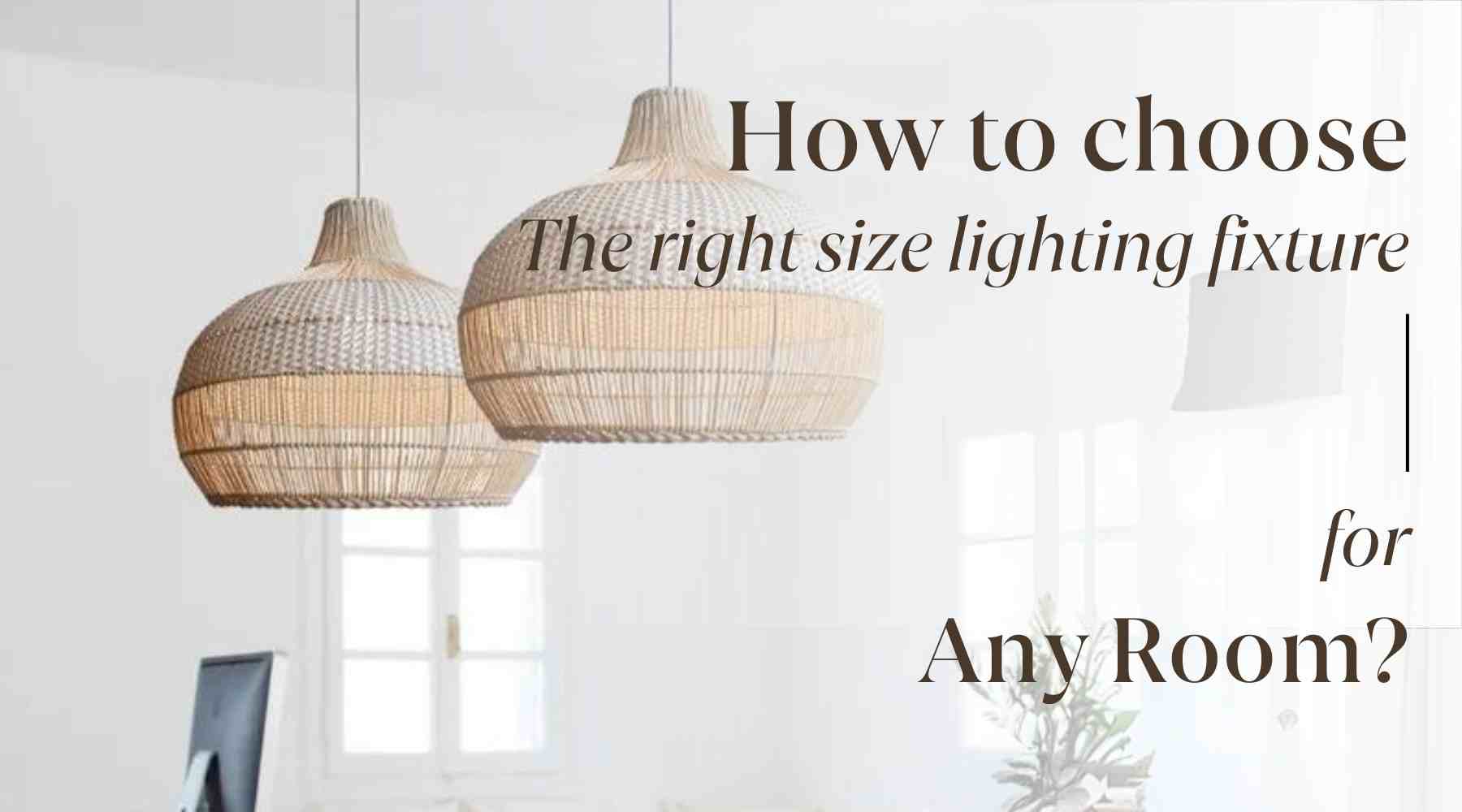
As a result, some fixtures may appear oversized or get lost in the space, failing to create a focal point. This article from Rowabi provides a pendant light size guide to help individuals answer the question "How big of a light fixture do I need?" in detail and clarity.
- Factors to consider when choosing light fixture sizes
- Room size and scale
- Light fixture diameter by dining table size
- Ceiling height
- Spacing for multiple light fixtures
- Purpose of the room
- Light fixture sizing basics
- Pendant light size guide
- Chandeliers above the table
- Chandeliers as ambient light
- Pendants for an island or table
- Pendants for ambient lighting
- Outdoor wall lighting and door fixtures
- Garage outdoor lighting
- Ceiling-mounted outdoor lights
- Outdoor hanging light fixtures
- Outdoor post lighting
- Bedroom ceiling fans
- Ceiling fans for other rooms
- Foyer lighting Selection
- Sconces for bathroom vanity lighting
- Sconces along staircases
- Tips for choosing the best light for your style
- Mid-century modern lighting
- Modern lighting
- Traditional lighting
- Coastal lighting
- Farmhouse lighting
- Design tips for selecting light fixtures
- FAQs - Choose the right size lighting fixture
- Conclusion
Factors to consider when choosing light fixture sizes
Choosing the right and suitable light fixture depends on more than just personal preferences. There are five key factors to consider, including room size and scale, light fixture diameter relative to dining table size, ceiling height, spacing for multiple light fixtures, and the room’s purpose.
Room size and scale
The dimensions of the room play a crucial role in selecting the size of light fixtures. Simply put, you must choose fixtures that harmonize with the overall space. Choosing small fixtures in large rooms may result in them getting lost in the space, while selecting oversized fixtures in small rooms can overwhelm and dominate the area.

The lighting fixtures need to be well-proportioned to the entire room. Source: Storables [1]
Additionally, consider both the furniture and architectural features of the room to choose light fixtures that integrate seamlessly with the overall aesthetic.
Light fixture diameter by dining table size
Certainly, lighting above the dining table is indispensable in our homes, where the family gathers for meals, isn't it? For such cases, there's a general guideline: choose a fixture with a diameter that is approximately one-half to two-thirds the width of the dining table. This ensures that the light adequately illuminates the entire surface of the table in the most natural way possible.
Ceiling height
Ceiling height is crucial and greatly influences the choice of suitable light fixtures. For instance, pendant lights often come with suspension cords, so the height of the ceiling affects how they are hung and how the light turns out in the room. Rooms with high ceilings can accommodate larger fixtures with more intricate details. In contrast, those with low ceilings should opt for lower-profile fixtures to avoid feeling cramped and to prevent any risk of bumping one's head when moving around.
Spacing for multiple light fixtures
Some spaces demand more than just one light fixture, excluding chandeliers. These areas often serve as gathering spots with high activity levels, such as kitchens, hallways, or living rooms. Therefore, multiple light fixtures are necessary. In such cases, it's crucial to consider the spacing between them when purchasing and selecting the appropriate type and quantity. They should be spaced evenly to ensure a balanced proportion for the entire room.
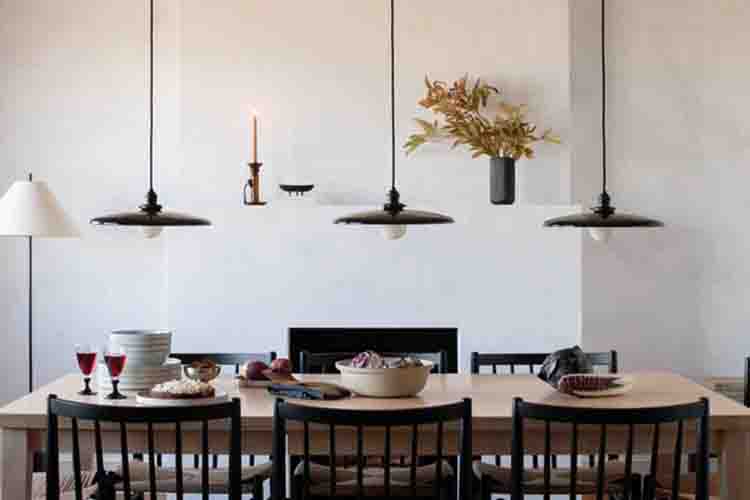
Multiple light fixtures should be evenly spaced. Source: Schoolhouse [2]
Purpose of the room
The purpose of a room is a significant hint in selecting the appropriate light fixture. For task-oriented spaces like kitchens and home offices, focused lighting is essential for efficient work and household tasks. Therefore, we recommend fixtures such as rattan pendant lights, glass lights, or linear fixtures for optimal performance. Conversely, rooms like bedrooms require soft lighting, for which fixtures like schoolhouse lights, which provide gentle and soothing illumination, are suitable choices.
Light fixture sizing basics
Certainly, we will have simple general principles to determine the appropriate size. Here, we have sizing basics for three types: a singular light fixture in a room, a light fixture above a dining table or kitchen island, and multiple fixtures over a table or island. These principles provide a foundation for selecting fixtures that suit the space and fulfill its lighting requirements effectively.
For a singular light fixture in a room
For a singular light fixture in a room, it's crucial to consider the room's size and scale. The best approach is to choose a fixture that complements the room's dimensions without appearing disproportionately small or large.
A useful rule of thumb is to add the length and width of the room in feet, and the resulting number can be the diameter of your fixture in inches. For instance, a room that's 12 feet wide by 12 feet long could accommodate a light fixture with a diameter of around 24 inches.
For a light fixture above a dining table or kitchen island
For light fixtures above a dining table or kitchen island, it's essential to select a fixture that is wide enough and provides sufficient brightness. Our recommendation is to choose a fixture with a diameter that is approximately one-half to two-thirds the width of the surface it is placed above. This ensures adequate coverage and illumination for the area without overwhelming it.
For multiple fixtures over a table or island
When installing multiple fixtures over a table or island, ensure they are evenly spaced along the length of the surface to achieve balanced lighting. Keep a distance of approximately 18 to 24 inches between each fixture. Adjust the height of the fixtures to align with the ceiling height and desired lighting effect, typically hanging them 30 to 36 inches above the tabletop or island surface.
Pendant light size guide
At each location, different measurements are required to determine the optimal distance and number of lights. Therefore, below, Rowabi has compiled and analyzed common lighting placement scenarios for further examination.
Chandeliers above the table
As a rule of thumb, the diameter of individual pendants should be approximately one-third of the width of the table. For instance, if your table measures 36 inches wide, aim for pendants with a diameter of around 12 inches each.
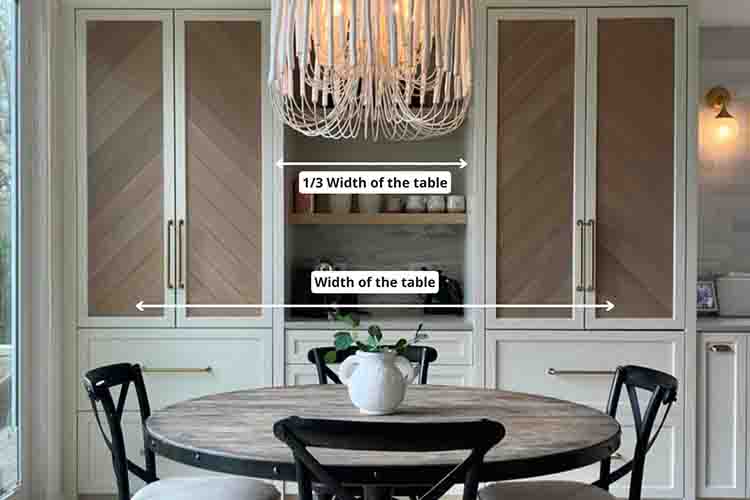
In the case of a cluster, ensure that the combined lengths of the pendants also total approximately one-third of the table's width. Hang the pendants at a height of approximately 30 to 36 inches above the tabletop for optimal illumination.
Chandeliers as ambient light
For ambient lighting fixtures, a simple formula can be used for measurement: add the length and width of the room (in inches) together to determine an appropriate fixture width. To select the height, multiply the room height by 2.5 or 3, resulting in a range from which you can choose chandelier heights.
Pendants for an island or table
For pendants above an island or table, measure the width or diameter of the surface and subtract 12 inches from that number. This is the maximum limit for the width or diameter of a hanging light fixture. However, you can scale down the maximum width slightly based on whether you prefer the fixture to appear larger or smaller.

Pendants for ambient lighting
Similar to chandeliers, to determine the ideal height for a chandelier, multiply the room's height by 2.5 and 3. For example, if the room has a 10-foot ceiling, the resulting range for chandelier heights would be between 25 and 30 inches.
Outdoor wall lighting and door fixtures
To ensure the right size for outdoor wall lighting and door fixtures, divide the front door's height by 3 (for a single lantern) and 4 (for 2 lanterns), then select fixtures measuring around one-third to one-fourth of the door's height. This maintains proportionality without making the fixtures appear disproportionately small or large.
Garage outdoor lighting
For optimal curb appeal, ensure your exterior garage lights measure one-third to one-quarter the height of your garage door. Calculate the specific fixture size by multiplying the door width by 0.25 for a single door or 0.33 for a double door. When installing multiple wall lanterns, each lantern's height should be about one-fourth the door's height, while a single lantern should be approximately one-third the door's height.
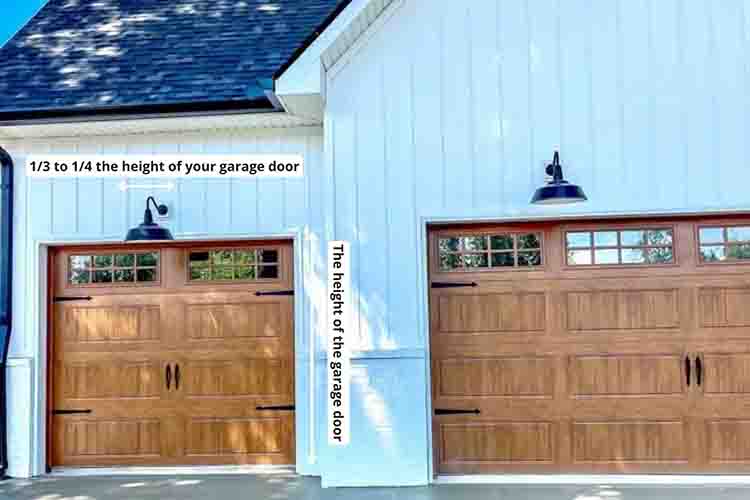
Ceiling-mounted outdoor lights
To accurately determine the size of ceiling-mounted outdoor lights, calculate the fixture's diameter range by multiplying the area's square footage by 0.5 to 1.5. For instance, for a 100-square-foot area, the recommended fixture diameter would fall between 50 to 150 inches.
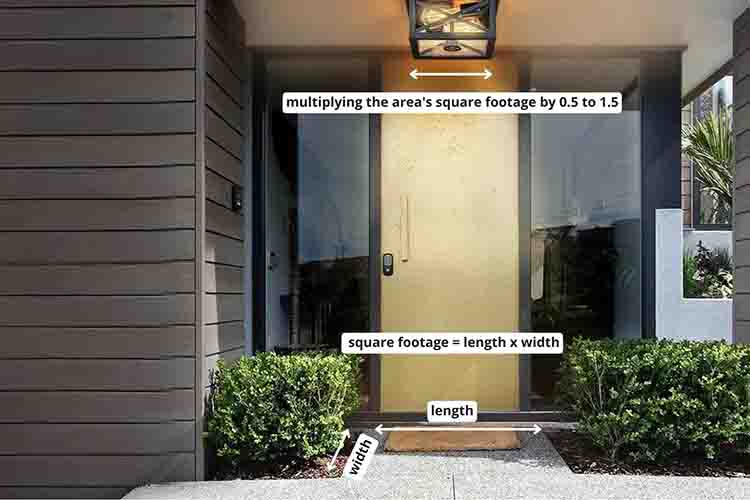
Outdoor hanging light fixtures
For a front door with a hanging lantern, aim for the lantern's height to be roughly one-fifth of the door's height. Ensure to account for the additional length of the chain or stem when hanging the lantern, and ensure that the lantern does not hang lower than 7 feet from the ground, including the fixture, chain, and stem.
Outdoor post lighting
To accurately size outdoor post lighting, measure the outdoor post's height in feet and evaluate the area you wish to illuminate, typically measured in square feet. Multiply the square footage of the area by a factor between 1.5 to 2 to determine the recommended lumens needed for sufficient lighting.
Bedroom ceiling fans
To accurately size a bedroom ceiling fan, measure the room's length and width in feet, and then calculate the total square footage. Based on the room's square footage, choose a ceiling fan with an appropriate blade span, such as 29 to 36 inches for rooms up to 75 square feet or 54 inches or larger for rooms exceeding 225 square feet. This ensures optimal air circulation and comfort in the bedroom.

Ceiling fans for other rooms
Similar to the bedroom, to accurately size ceiling fans for other rooms, measure the room's length and width in feet to calculate the total square footage. Then, based on this measurement, choose a fan with an appropriate blade span, such as 29 to 36 inches for rooms up to 75 square feet or 54 inches or larger for rooms exceeding 225 square feet. Install the selected ceiling fan, ensuring proper clearance for optimal air circulation and comfort throughout the room.
Foyer lighting Selection
For precise foyer lighting selection, ensure that the chandelier or pendant's height is proportional to the ceiling height. Aim for 2-3 inches of fixture height for each foot of ceiling height. Similarly, a two-story foyer can accommodate a larger chandelier or pendant ranging from 32 to 48 inches in height. This ensures aesthetic balance and proportionality.

Sconces for bathroom vanity lighting
For bathroom vanity lighting with sconces, mount them precisely at 65 inches above the finished floor, aligning the bottom edges of shades slightly below eye level to minimize glare. Place the sconces precisely 36 to 40 inches apart, flanking the mirror, with a distance of 18 inches from the sink's center line.
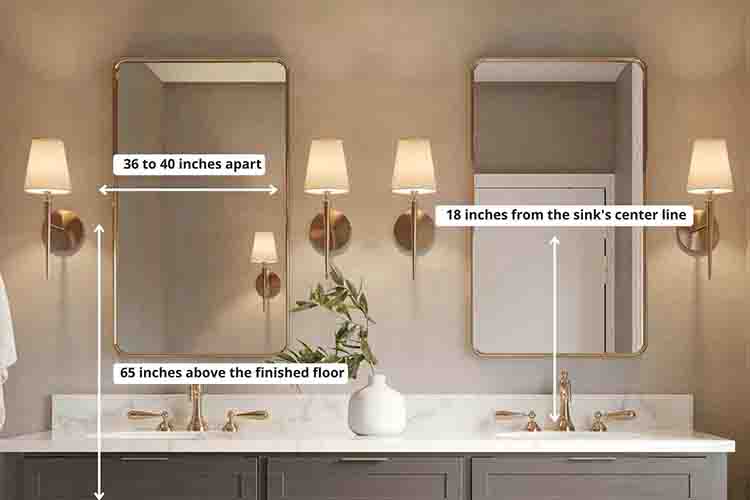
One small tip: opt for sconces of 12 inches or less for smaller bathrooms and sconces around 18 inches tall for average-sized bathrooms, while larger bathrooms can accommodate sconces measuring 19 inches or taller.
Sconces along staircases
For placement of sconces along staircases, measure the ceiling height in inches and multiply it by 3/4, as sconces are typically positioned three-quarters of the way up the wall. For example, with 8-foot (96-inch) ceilings, sconces would ideally be placed around 6 feet or 72 inches up.
Tips for choosing the best light for your style
Each style has particularly suitable lights that accentuate its beauty. Below are some typical styles for you to consider and choose from, including mid-century modern, modern, traditional, farmhouse, and coastal lighting.
Mid-century modern lighting
During the mid-20th century, we witnessed the emergence of numerous iconic designs. They were elegant and groundbreaking, yet still clean, simple, and timeless. Designs focused on functionality while maintaining a tidy appearance, emphasizing meticulous attention to detail.
This style often utilizes materials such as wood, metal, and glass, combining textures and finishes to create refined lighting. Brass, walnut, and frosted glass are commonly associated with mid-century modern lighting. For pendant lights, opt for designs with globe-shaped shades or, preferably, teardrop shades.
Modern lighting
With the primary principle of "less is more," modern lights typically feature clean lines and minimal ornamentation. For busy modern individuals, prioritizing functionality in their homes is paramount.

The emphasis lies not in the details but in the unique overall perspective. Source: Decorilla [3]
Lighting with sleek metal finishes such as brushed nickel, chrome, or matte black brings a minimalist, functional beauty that is understated and unobtrusive. Its highlight lies precisely in how it seamlessly blends with its surroundings.
Traditional lighting
Traditional lighting is characterized by its refinement, sophistication, and ability to showcase the enduring presence of these fixtures over time. This is because classic design is often accompanied by subtle intricacies that reveal their beauty and essence upon closer inspection.
These lights, whether chandeliers or lamps, typically utilize timeless materials such as crystal and glass. Fabric shades used in lamps often feature patterns like damask, toile, or floral motifs. All of these elements combine to create a gentle, warm, and nostalgic ambiance.
Coastal lighting
As summer approaches, the coastal style is set to reign supreme with its refreshing and relaxed vibe reminiscent of cool sea breezes. Coastal lighting embodies this aesthetic with grace and ease. Materials such as rattan, rope, and driftwood perfectly capture the essence of coastal living.
Pendant lights crafted from woven materials, ranging from minimalistic to uniquely intricate designs, bring a fresh seaside charm to any space.
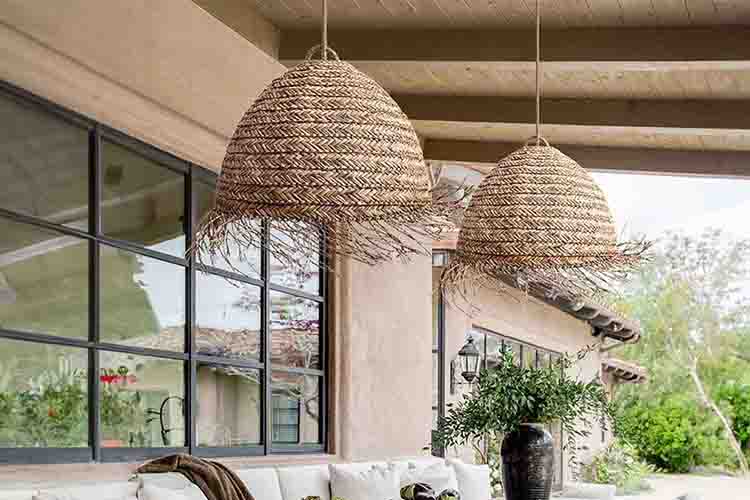
The Selene Seagrass Pendant Light is commonly used in outdoor coastal-style areas. Source: Rowabi
Rattan, in particular, has emerged as a favored material in recent years. Its affordability, versatility in shaping, and durability make it a practical yet fashionable choice for coastal-inspired decor.
Farmhouse lighting
The farmhouse style truly embodies timeless lighting, as it evokes feelings of warmth, familiarity, and tranquility. It creates a sense of being in a peaceful area where one can immerse oneself in nature, simplicity, and relaxation.
Therefore, farmhouse lighting fixtures exude a similar vibe, such as mason jar or lantern-style shades. They can also feature rustic elements like distressed finishes, wrought iron, and reclaimed materials. Additionally, farmhouse lighting can be combined with industrial style by incorporating exposed bulbs, wire cages, and metal accents.
Design tips for selecting light fixtures
Here are some tips that Rowabi has consistently used to select the most stunning light fixtures for clients, which will be revealed below.
Maintain balance
Balance is a concept frequently emphasized in both interior design in general and lighting design in particular. Here, balance refers to the proportional relationship between each object within a room.
Each object has its own proportion that harmonizes with and enhances the overall composition. In this case, an appropriate light fixture typically occupies around one-third of the width of the entire room, ensuring that smaller spaces are not overwhelmed by overly large fixtures and larger rooms do not feel cramped with tiny ones.
Consider style and function
No matter how much you may like a particular light fixture, if it doesn't complement the overall style of the home or serve its intended purpose effectively, it's best to exclude it from consideration and explore other options.
Each room will require a specific type of lighting, categorized as accent, ambient, or task lighting. Therefore, it's essential to determine the purpose and intent of the lighting from the outset to make a careful selection.
Try layered lighting
Layering is a suitable method for those seeking to make a room versatile and multifaceted. This means that within a room, there should be sections where ambient lighting is crucial to create a shared space for the whole household.
However, there are also areas where accent or task lighting is desired to focus on specific zones. By combining these layers, you can create a flexible lighting scheme that addresses different needs and moods.
Don’t be afraid of size
While we've discussed the established principles for selecting the most suitable light fixtures, if you're inclined towards innovation, seeking to completely transform the look of a room, and expressing your personality, oversized fixtures might be a perfect fit. However, careful consideration and possibly seeking advice from professionals are necessary to choose the most suitable one.
FAQs: Choose the right size lighting fixture
What is the rule of thumb for light fixtures?
- Selecting a light fixture proportional to the room's size is a common guideline. A large chandelier or pendant suits sizable dining or living rooms, while smaller, delicate options are preferable for smaller bathrooms or bedrooms.
Can a light fixture be too big?
- Yes, a light fixture can indeed be too big for a space. Oversized fixtures may overwhelm the room, detracting from the original aesthetic.
How big should a light fixture be over a table?
- A light fixture positioned over a table is ideally sized to have a diameter ranging from one-half to two-thirds of the table's width.
How do I choose a ceiling light fixture?
- When choosing a ceiling light fixture, consider the room's size, ceiling height, and style. Always make sure the fixture complements the overall aesthetic and provides enough light for its intended purpose.
What are the 3 rules of lighting?
- The three key rules of lighting involve layering light (ambient, task, accent), ensuring proper fixture size and placement, and selecting the suitable light temperature (warm or cool) for the desired ambiance.
Should light fixtures match in a house?
- While light fixtures in a house do not have to match, maintaining consistency in style or finishes can establish a cohesive aesthetic throughout the home.
How far down should a light fixture hang?
- As a general guideline, pendant lights should hang approximately 30 to 36 inches above a table or counter, with the precise height varying based on the room and the fixture's purpose.
How low should a light fixture hang in a living room?
- For living rooms with standard 8-foot ceilings, light fixtures should ideally hang approximately 12 to 18 inches below the ceiling, taking into account the fixture's style and the overall ceiling height.
Can a light fixture short out?
- Yes, light fixtures can short out due to electrical issues, wiring problems, or water damage.
Can I put a round chandelier over a rectangle table?
- Yes, a round chandelier can be placed over a rectangle table, as long as its size and shape complement the table's dimensions and the overall aesthetic.
How far should a light fixture hang above a kitchen table?
- Ideally, a light fixture above a kitchen table should hang approximately 30 to 36 inches above the surface to ensure adequate lighting.
How big should a dining room light fixture be?
- Generally, the diameter or width of the fixture should range from one-half to two-thirds the width of the dining table it hangs above.
What is the trend for ceiling lights?
- Contemporary ceiling light trends lean towards minimalist designs, featuring sleek lines, geometric shapes, and neutral finishes.
What is the best layout for ceiling lights?
- The optimal layout for ceiling lights depends on factors such as room size, function, and layout. A balanced combination of ambient, task, and accent lighting is recommended.
What kind of ceiling light makes a room look bigger?
- Recessed lighting or flush-mount ceiling lights with a wide, diffused light spread can create the illusion of a larger room.
What are the 4 laws of light?
- The four fundamental laws of light are reflection, refraction, absorption, and transmission. These principles govern how light interacts with surfaces and materials, affecting factors like color, brightness, and visibility.
What are 4 types of lighting?
- The four main types of lighting include ambient lighting (providing overall illumination), task lighting (focused on specific activities or tasks), accent lighting (highlighting architectural features or decor), and decorative lighting (adding aesthetic appeal).
Should all bedroom ceiling lights be the same?
- While bedroom ceiling lights don't necessarily have to match, maintaining consistency in style or finish can create a cohesive look.
Conclusion
This comprehensive guide has explored the various aspects of selecting the perfect lighting fixture size, offering practical guidelines and tips to help you make informed decisions. With these tips in mind, finding the perfect fixture size becomes a breeze. You are now ready to create stunning, well-lit spaces.
Source:
- [1]: https://storables.com/articles/what-size-of-light-fixture-is-for-living-room/
- [2]: https://www.schoolhouse.com/blogs/how-to/choose-the-right-size-chandelier-or-pendant
- [3]: https://www.decorilla.com/online-decorating/lighting-interior-design/
Related Posts

Kitchen Island Lighting: How To Choose The Right Lights For Your Kitchen Island?
Kitchen islands have become an increasingly popular trend in recent home construction. According to the 2020 U.S. Houzz Kitchen Trends Study [1], which surveyed nearly 2,600 users, 61% of upgraded ...

Furniture Near Me: 10 Must-Visit Stores at Texas
Get ready for an epic furniture hunt in the sprawling state of Texas! The Lone Star State is not only known for its vast landscapes but also for its incredible furniture stores near me. Rowabi is h...


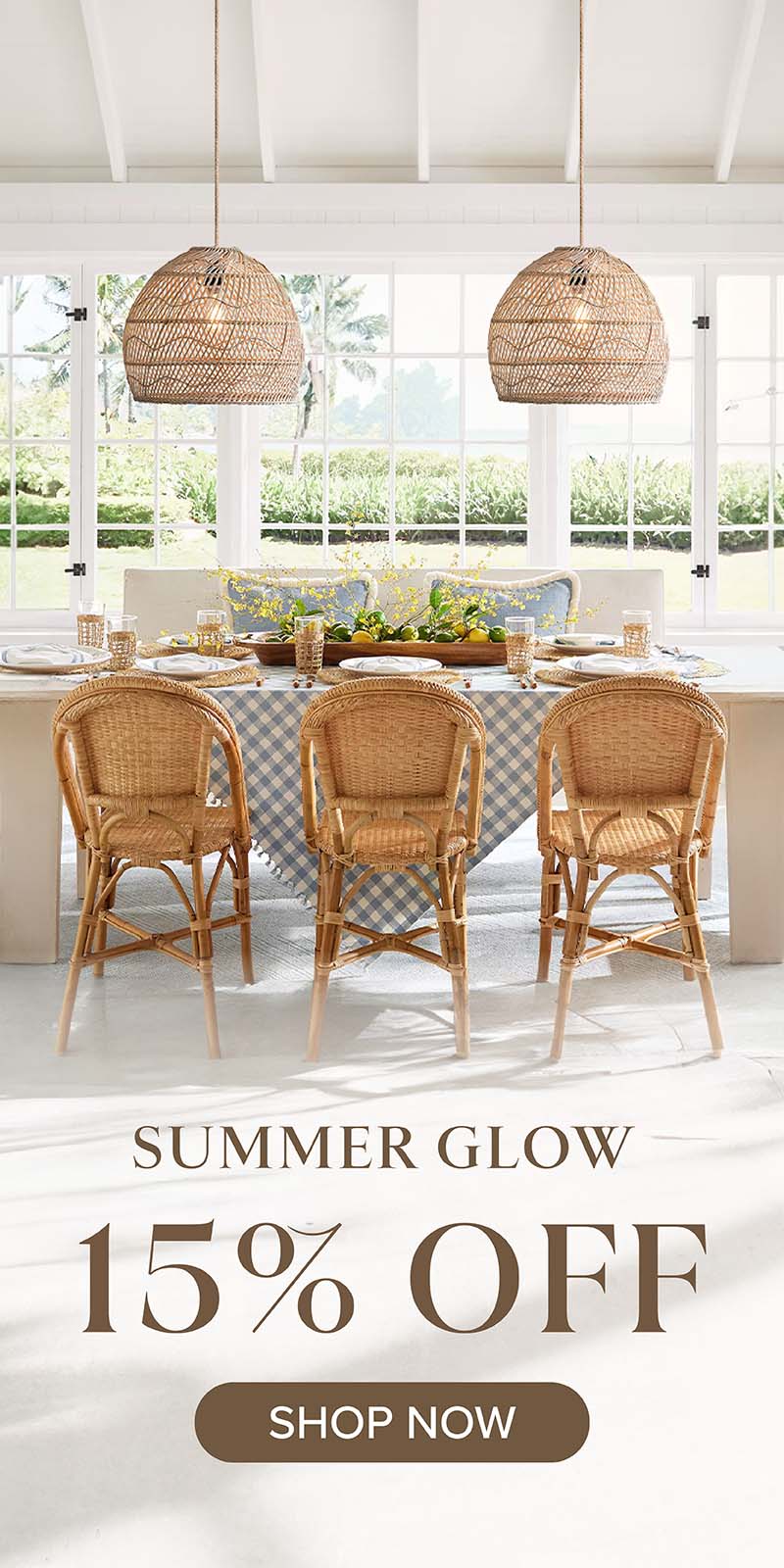
Leave a comment
This site is protected by reCAPTCHA and the Google Privacy Policy and Terms of Service apply.